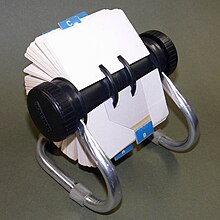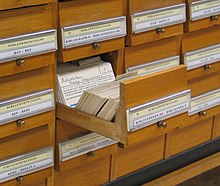Card index
A card index is an ordered collection of data on small-format cards, each of the cards standing for an information unit and thus representing an object of reality.
A card index is arranged to make it easier to find the data it contains. They can be arranged alphabetically, according to a date or according to other criteria.
A card index is usually written or printed on index cards , and the process itself is referred to as the mapping of data. The index cards are stored in a file box according to their arrangement. By attached at intervals tab short tab , the tab is kept clear. (See also note box .)
In order to use a card index efficiently, the correct arrangement of the cards is essential; otherwise, data cannot be found.
For duplication and archiving, card files are analogously photographed on microfiches and can then be used with special readers.
By the end of the 19th century, the edge punch cards , in which holes are punched in the edge of the card, and slot punch cards, in which the holes are in the card surface, developed. These hand punch cards allow the coding of features of the content that are noted on the index card. Long needles inserted through the corresponding holes allow simple Boolean operations on coded card stacks.
Index cards and databases
A card index can be electronically mapped to a database . In contrast to a database, however, a card index usually only consists of a single collection of index cards with the same structure. The electronic equivalent of a card index is therefore the table of a database. An index card then corresponds to one line in this table.
File types
There are two types of files:
- Steep index:
- Block card index, the cards are placed one behind the other in a container, as only one card can be read at a time, they must be broken down by means of organizational features;
- Inclined view card index (block view card file), the cards standing one behind the other contain labeled inclined flags as order features (angled view);
- Advantages and disadvantages: Overview: low; Completeness check: difficult; Additional options: very good; Space requirement: low; Cost: low
- Easel file:
- Flat view card index, the cards are placed on top of each other in a graduated frame, the lower edge of each card is visible and contains the constant data;
- Wide-scale viewing card index, the cards are arranged one behind the other in the form of a scale so that a border (right and left) for labeling with information is visible in front of each card;
- Advantages and disadvantages: Overview: very good; Completeness check: very easy; Additional options: low (additional containers); Space requirement: very high; Cost: high
Examples
- Ancestral Index
- Block card index, broad-scale card index, Bücker index, movement data, library catalog
- Print date
- Subject index, flat scale index
- Birthday card
- Hanging card index
- Inventory file, delivery file, learning card
- Membership card, dunning card
- Means of order
- Personal files, patient files, examination files
- Radion card index
- Stripe file, oblique view card file, student file, record file, master data, item file
- Appointment file
- Vertical grading file
- Note box
See also
literature
- Markus Krajewski: Paperwork. The birth of the card index from the spirit of the library. Kulturverlag Kadmos, Berlin 2002, ISBN 3-931659-29-1 ( Copyrights 4).
- Hans Petschar, Ernst Strouhal , Heimo Zobernig : The card catalog. A historical system of spiritual order. Springer, Vienna et al. 1999, ISBN 3-211-83273-4 .
- Walter Porstmann : Index card. The manual of map technology. 4th revised edition. Schwabe, Berlin 1950.



